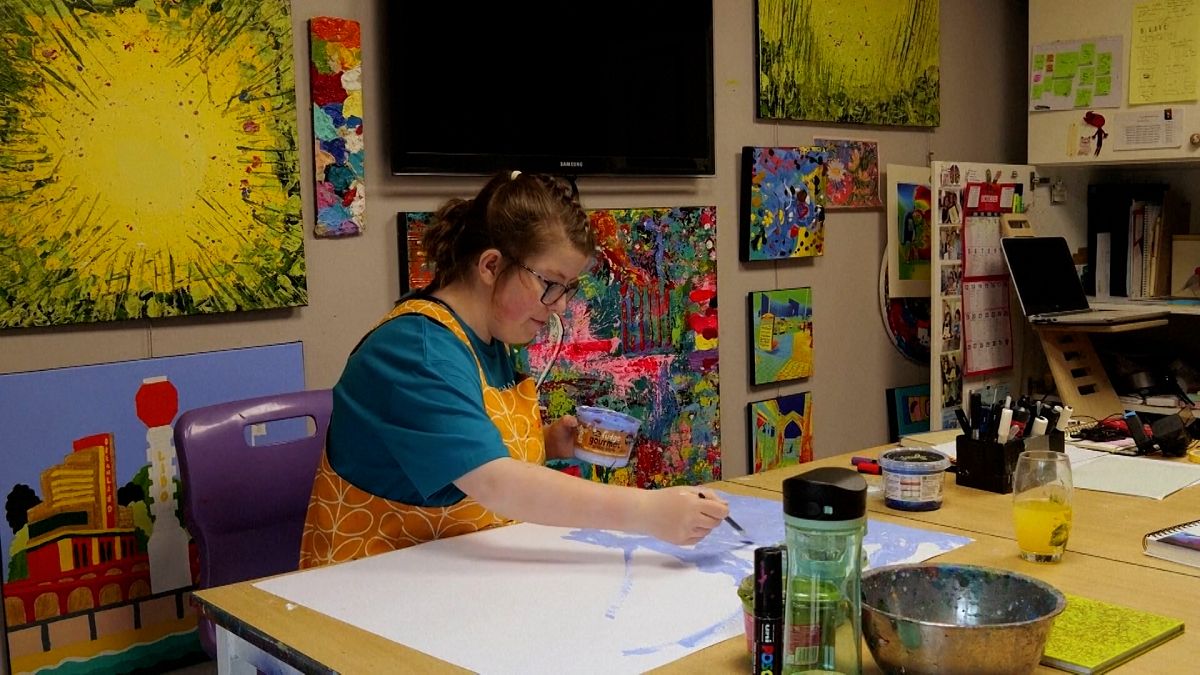In a bright, paint-splattered studio in Kent, CeCe Balfour leans over her latest canvas. Blue, she says, is her colour of choice.
The 19-year-old has been painting at the Sandra Art4All Studio since she was 12. Like most of the artists who come here, CeCe is autistic.
“Art is so fantastic. I can be with my friends. I can see Sandra. It’s like a family to me,” she says.
The project was set up by Sandra Hampton nine years ago, and has since become a thriving creative hub for autistic artists. Each week, participants gather for one-on-one or small group sessions to paint, draw or experiment with photography.
Hampton, who set up the project after being made redundant following the closure of a special needs school, says she’s witnessed remarkable transformations.
“Throughout the nine years I’ve been working with this particular group of artists, I have seen every one of them come through real emotional difficulties. Art is a great way of helping us, not necessarily verbally understanding what we’re going through, but to be able to express it in a very silent way. Some of our artists are able to have small discussions around how they feel in their emotions. Some of them are non-verbal,” she says.
The studio’s success is clear to see. Its most recent summer exhibition at The Margate School of Art sold more than 70 works – a record for the group.
“Our exhibitions, when you walk into them, don’t shout out disability. It shouts out colour. It shouts out joy. We’ve made art what we’ve wanted to, in the way we’ve wanted to, and then we present it as professionally as we can,” says Hampton.
Proceeds from the sales go towards running costs, resources for the studio and paying the artists themselves. The team is now preparing a 12-piece canvas commission – their first of this kind – while also planning next year’s summer show.
“We need neurodivergence”
But the studio’s sense of celebration has recently been clouded by comments from US President Donald Trump, who has revived discredited claims linking autism to vaccines and medicines such as Tylenol (paracetamol).
In September, Trump warned pregnant women not to take the drug and fuelled long-debunked theories about autism’s causes.
CeCe’s mother, Vicky Balfour, says she was “heartbroken” after hearing the comments.
“It upset me because, partly as a woman, it felt very much as an attack against women. Once again, it was the patriarchy. It was like, yes, you are a woman, you’ve done this, it’s your fault,” she says.
“We wouldn’t be where we are if we didn’t have people with neurodivergence, if we didn’t have a lot of the scientific and medical and mathematical society. We need neurodivergence. We need that different perspective. And also, it’d be really boring if we were all the same,” she adds.
Trump’s administration has since announced a new initiative to study the causes of autism – though critics point out it largely relies on existing research and has been shaped by figures associated with the anti-vaccine movement, including supporters of US Health Secretary Robert Kennedy Jr.
For Harriet Needham-Steddy, 22, another artist at the Sandra Art4All Studio, the remarks struck a nerve. “I was angry. I’m autistic. And I don’t take insults to our sort of people like that lightly,” she says.
Her mother, Deb Shotton, adds: “People who write off a whole spectrum of other humans for a kink in their neuro-spiciness, it’s a terrific shame. And you’re missing out on a whole raft of possibilities when you do that.”
According to the UK’s National Autistic Society, autism is a “lifelong neurodivergence and disability” that affects people in different ways. Some individuals are non-verbal, while others experience only mild differences in communication or perception.
“There will not be a cure. And what we should be focusing on is making quality of life better for autistic people who are here today,” says Zoe Gross, Director of Advocacy at the Autistic Self Advocacy Network.

